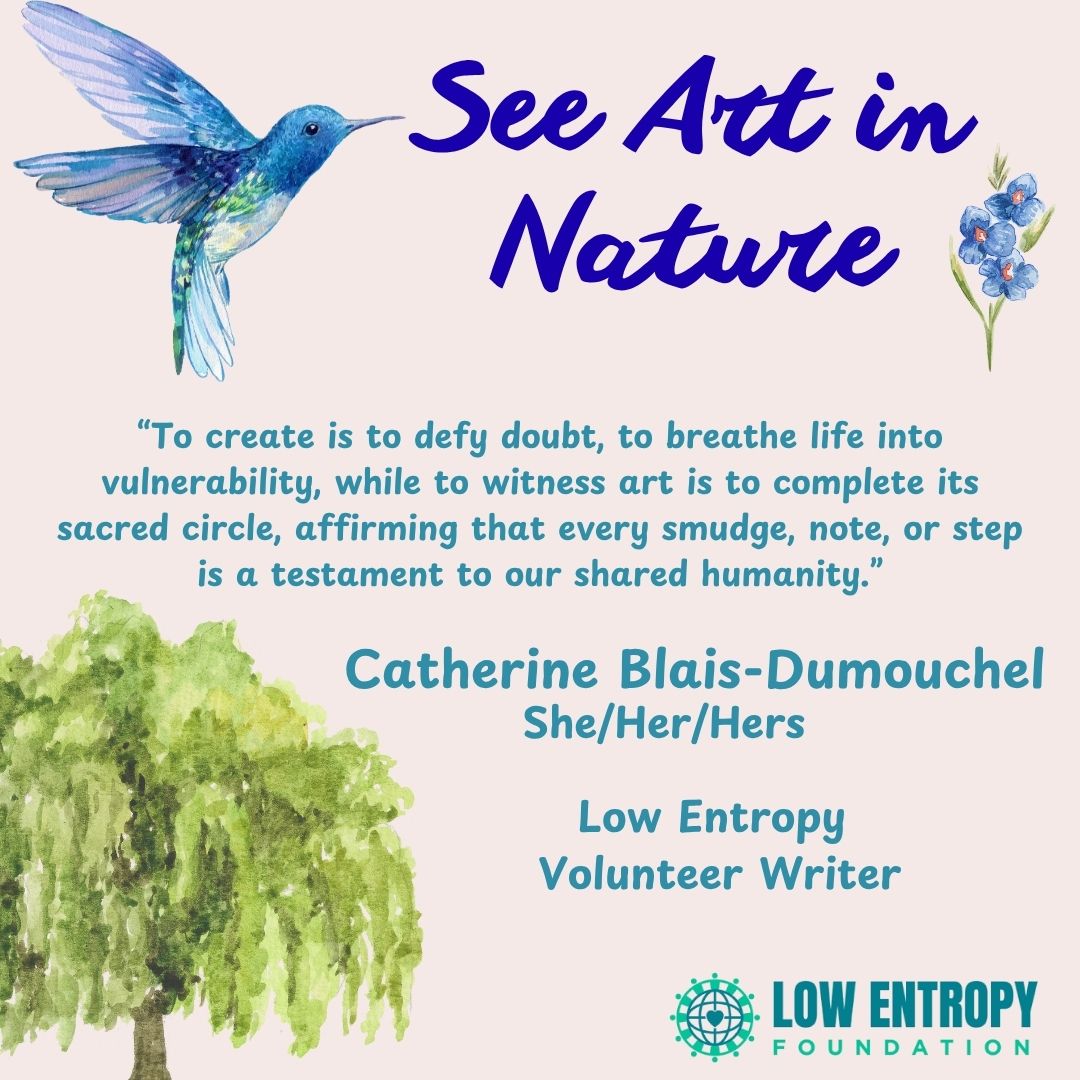Catherine Blais-Dumouchel, Low Entropy Volunteer Writer
When we walk through the woods or sit quietly by a lake, we don’t just see plants and rocks—we see art. Nature is the original artist and her gallery is vast, wild and magnificent. Over time, many of us come to realise that art isn’t only found in studios or galleries. It’s in the folds of a mountain, the ripple of a stream and the shimmer of sunlight on leaves. Let’s take a closer look together.
Nature sculpts with time and power. When we look at mountains and valleys—these are grand shapes formed over millennia by tectonic drama and the persistent touch of wind and rain. They rise and dip like frozen waves, bold and breathtaking. Canyons and caves, carved slowly by water and time, are equally compelling. Each layer of sediment tells a story, revealing our shared history like brushstrokes on stone. We can almost feel the passage of ages in their textures. Sand dunes and ocean waves are kinetic sculptures, constantly moving, shifting, dancing. They are shaped by rhythm and flow, like music turned into motion. One moment they’re soft and serene, the next they rise up dramatically.
Looking even closer, we find that nature doesn’t just work in big gestures—there’s elegance in the details. Snowflakes, for example, are like tiny frozen mandalas. No two are the same, yet each one is perfectly symmetrical. They fall quietly, leaving intricate artwork on our sleeves and windows. The veins in a leaf or the circles of tree rings are nature’s version of line art—intricate, precise and full of meaning. These patterns aren’t random; they tell stories of growth, seasons and survival, waiting for us to discover them. And who can ignore the spiral? From the tight coil of a snail shell to the sunflower’s seedhead or the graceful curl of a fern’s fiddlehead, this ancient form repeats itself across the natural world. It’s a quiet kind of beauty, grounded in rhythm and balance.
Nature is fearless with her palette. Sunrises and sunsets paint the sky with watercolour brilliance—rosy pinks, golden oranges and moody purples that no brush could fully capture. Water may be the most expressive artist of all. From the pale turquoise of alpine lakes to the deep indigo of the open sea, its colours shift with light, depth and sky. It’s like nature’s liquid canvas, reflecting mood and movement. Bird plumage and butterfly wings offer their own kind of silent glamour—tiny flying canvases with stunning hues, jewel tones and elegant contrasts that rival the most detailed of paintings.
Art is not just shapes or colours, but also how light plays across surfaces. In a forest, sunlight filters through the leaves, scattering patterns that dance on the mossy floor. It’s like watching a live impressionist painting. When the moon reflects on water, we witness a moving light show. Each ripple catches and bends the light, creating trails that shimmer mysteriously. Look up and we’ll see clouds—those soft-edged sculptures in the sky, constantly shifting, glowing with sunrise or heavy with storm. They are the sky’s ever-changing light installations.
This one isn’t visual, but hear me out—nature’s music is a form of art too. Birdsong greets us each morning with unique melodies, different in every place and season. It’s like a locally curated soundtrack, composed by feathers and instinct. The wind through the trees is a rustling symphony, rising and falling with rhythm and mood. Sometimes warm, sometimes eerie, it’s both a background and a centrepiece. And rain, with its gentle patter or thunderous percussion, can calm or stir the soul like any good score. It reminds us that art can be felt just as much as seen.
So the next time we’re out on a trail, sitting beneath a tree or simply watching the clouds from our window, let’s take a moment to notice the art around us. Nature doesn’t ask us to understand every detail—only to pay attention, to feel and to be moved. After all, art is everywhere. We just have to look.
—
Leave your thoughts for Catherine in the comments below. You can also follow us on Facebook, Instagram, TikTok, LinkedIn and YouTube to stay up-to-date with Low Entropy news!

